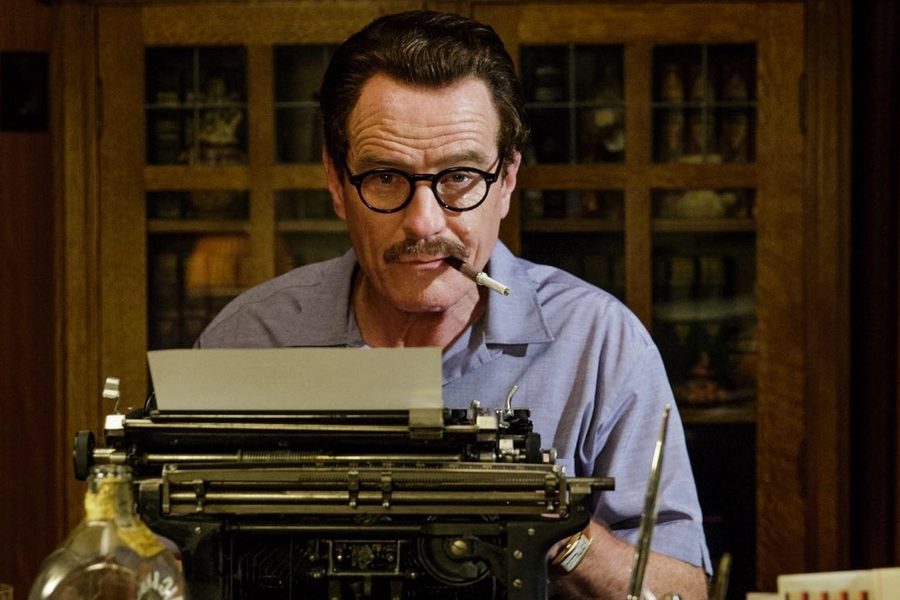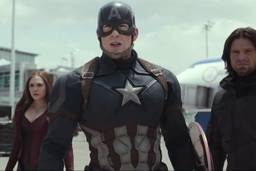The Blacklist in ‘Trumbo’ Didn’t Just Restrict Free Speech. It Changed How We Talk About Freedom.
Trumbo misses the opportunity to tell a more faithful, radical narrative of cinema’s Red Scare and its resistors.
Andrew Paul

In an early scene of Trumbo, the film’s eponymous screenwriter protagonist confronts the famous actor John Wayne. The year is 1947, and John Wayne is one of the leaders of the Motion Picture Alliance for the Preservation of American Ideals (MPA). The MPA is trying to figure out how to kick those with progressive politics out of Hollywood. They would soon succeed by helping to inaugurate the notorious Hollywood blacklist.
Dalton Trumbo is one of those progressives: a member of the Communist Party, which during those years, adopted a politics that was more Bernie Sanders than Josef Stalin. Trumbo and Wayne’s dialogue lays bare the ideological disagreement that separated the MPA and the many actors, writers, directors, and craftsmen and women that sought social justice in the form of labor rights and racial equality, and thought some of those ideas could make it onto the screen. Wayne and Trumbo were fighting for the way their own industry would operate. And they were also fighting for the future of American popular discourse. Trumbo wanted more films like Grapes of Wrath. Wayne wanted jingoistic cold war propaganda.
Later in the film, after Trumbo is blacklisted, and locked up in federal prison for refusing to cooperate with the House Committee on Un-American Activities (HUAC), he encounters a fellow inmate: a fictional African American and vehement anti-communist named Virgil Brooks. Brooks spits venom at Trumbo initially, but they eventually find common ground. When radios at the prison reveal to the inmates that Trumbo’s Hollywood friends have “named names,” that is, named men like Trumbo as communists in order to prove their own patriotism in front of Congress and the film studio heads, Brooks tells Trumbo that he has no sympathy for “snitches.” HUAC’s behaviour, its efforts to interrogate individuals for their thoughts and associations, is clearly abhorrent to him. The two antagonists put aside their differences over a common belief in moral integrity and civil liberties.
The film itself performs the same move. It starts out concerned with conflicts over social justice. In fact, it does what no other major studio Hollywood blacklist drama has done before: it presents its protagonist as a dedicated radical. In previous films such as The Majestic, Guilty by Suspicion, and The Front, the heroes have always been political naifs or moderate liberals. By contrast, early on Trumbo makes its sympathies clear: it is pro-labor, anti-jingoistic, and in favor of economic justice.
But much like the way that historians and cultural critics have come to talk about the Hollywood blacklist over the years, it settles into a narrative that emphasizes the principles of free speech and civil liberties as what are most worth fighting for. It sets aside the question of why the blacklistees were targeted in the first place, and instead seeks only to critique the means of the cultural warfare of the period. By doing so, it capitalizes on an intellectual consensus that was born from the 1950s. That is everyone can agree that regardless of our political beliefs or cultural worldviews, we should all recognize one another’s civil liberties and individual freedoms.
Movies like Trumbo tell us that the Hollywood blacklist is important. And indeed, I’m here to tell you that it matters, but not in the way that you might think. We tell it as a story about the lamentable defeat and triumphant return of civil liberties. We should instead tell it as a story of how our culture talks about freedom. The blacklist didn’t just ruin hundreds of people’s individual lives. It had the subtle and specious effect of re-prioritizing liberal and progressive values.
Civil Liberties and American History
Perhaps what’s most surprising is that Hollywood is not the sole source for this anodyne approach to the story of the blacklist. Historians focus on the civil liberties aspect too. In part, this is because the relationship between civil liberties and radical politics have changed over time.
In the 1920s, when the American Civil Liberties Union was in its early years, freedom of speech was understood to be essential to the labor movement. In fact, the ACLU insisted that free speech and civil liberties more broadly were only means to achieve an end of social and economic justice. This was an era when the United States Post Office routinely confiscated pamphlets or newsletters they deemed to be radical or anarchist, and non-citizens that condemned war aloud could find themselves deported.
By the 1950s however, civil liberties became a cudgel with which anti-communists could strike down critiques of American society. Intellectuals including Arthur Schlesinger, Jr., and Milton Friedman argued not only that individual liberty made the United States better than the Soviet Union. They also argued that the existence of American liberty made movements for social and economic justice unnecessary and wrongheaded.
To be clear, the victims of the Hollywood blacklist should not be faulted for invoking civil liberties. They were being strategic in appealing to the consensus principles of the time. But victims of the blacklist didn’t stop there. For example, screenwriter and Hollywood Ten member John Howard Lawson, while citing his right to free speech, also proclaimed fealty to matters of economic and civil rights:
Today, we face a serious crisis in the determination of national policy. The only way to solve that crisis is by free discussion. Americans must know the facts….[The House Committee on Un-American Activities]’s logic is obviously: Lawson’s opinions are properly subject to censorship; the industry makes pictures for the American people, so the minds of people must be censored and controlled.
Why? What are J. Parnell Thomas and the Un-American interests he serves, afraid of? They’re afraid of the American people. They don’t want to muzzle me. They want to muzzle public opinion….Because they’re conspiring against the American way of life. They want to cut living standards, introduce an economy of poverty, wipe out labor’s rights, attack Negroes, Jews, and other minorities, [and] drive us into a disastrous and unnecessary war.
We can contrast Lawson’s ideas about free speech with those expressed in 2015, at a moment when we’re seeing the limits of first amendment fetishism. On campuses across the country, movements for social justice have been opposed with specious arguments about the ways that the powerful and the privileged have been denied their civil liberties. Minorities are denied access to civil rights on the basis of “religious freedom.” Civil liberties have again become a cudgel. And unfortunately, our popular culture is more likely to contribute to its fetishism than to question how we collectively talk about freedom.
The Blacklist’s Happy Ending
As the political context of the Hollywood blacklist fades away about halfway though Trumbo, it recenters upon Dalton Trumbo’s efforts to defy the blacklist by making movies. If he can continue to write screenplays, he believes, he can defeat the villains of free speech. In real life, Trumbo’s fellow blacklistee Herbert Biberman did this too. Biberman made the film Salt of the Earth, which not only defied the blacklist because it was staffed by communists, but also because it celebrated the recent labor strikes of Latin American mine workers in the American southwest. Herbert Biberman sought to exercise his embattled civil liberties as a means to do exactly what communists were blacklisted for in the first place, attempting to make meaningful pictures that challenged or critiqued social injustice or imagined better worlds.
Dalton Trumbo, on the hand, at least according to the new film, sought to make no such efforts. Cranston’s Trumbo is obsessed with winning, with defeating the blacklist, but he is portrayed as understanding the fight itself as its own justification. As a result, Trumbo does something that every other blacklist film before it does too: it provides us with a happy ending. Civil liberties were embattled, but through the work of those blacklisted writers who made paeans to free speech and defied the function of the blacklist by working undercover, they brought about a new society in which all agree on the sanctity of individual freedom.
Blacklisted writers turned to civil liberties for the topics of their scripts quite justifiably. After all, it was a matter that was affecting them directly. But it deeply influenced the kinds of stories they wrote. For example, Ian McLellan Hunter, who is portrayed in Trumbo by Alan Tudyk, would go on to write for the hugely popular 1950s television show The Adventures of Robin Hood. The show was staffed exclusively by blacklisted writers, include Waldo Salt and Ring Lardner, Jr., and produced by the radical Hannah Weinstein. But for a show about Robin Hood, there was little redistribution of wealth on display. Instead, the show’s episodes allegorized the repressive red scare climate by portraying government as bad, and individual freedom as good. It romanticized a mythic past in which individual liberty was central to production.
As much of a step forward Trumbo is in the telling of the blacklist – particularly with regard to the film’s first half – what gets lost in the film is how the blacklist didn’t come with a Hollywood ending. Sure, on the battleground of civil liberties, the blacklistees triumphed. But on the battleground of civil rights – social, racial, and economic justice – the blacklistees lost. They were silenced because, as Eric Johnston, one of the blacklists architects put it, he and the MPA sought to “have no more Grapes of Wrath.” But they also lost in a different way.
Their efforts at resistance, which would shape postwar popular culture, were necessarily affected and transformed by the events of the red scare. Before the blacklist, Hollywood had been making films informed by Franklin Roosevelt’s conception of freedom as economic — “freedom from want” — and by the progressive era insistence that freedom was “social.” Such films included Black Fury, One Third of a Nation, You Only Live Once, and Gentleman’s Agreement, just to name a few. These movies addressed capitalism and intolerance, and featured characters that understood freedom as something that could only be understood in terms of people’s social relations with one another.
After the blacklist, radicals continued to write characters that sought freedom. But it was a path of resistance to write about civil liberties and individual freedom, as well as a path that spoke to their own personal experiences. As victims of artistic censorship, they felt less like Tom Joad and more like Jack Kerouac.
When Hollywood wants to get political, it’s easier for them to draw villains that seek to undermine our individual freedoms or take away our civil liberties than to show the effect of structural inequalities. Heroes, they presume, are more likeable when they are fighting against a social system than trying to imagine a new one. Consider comic book films like The Avengers and Captain America: The Winter Soldier, or independent films including Beasts of the Southern Wild. These disparate movies fetishize individual freedom by presenting institutions as necessarily bad, and by suggesting that all one needs in life is the complete freedom to make one’s own choices.
Such a message doesn’t just appear in movies about the Hollywood blacklist. It was actually born from the blacklist itself. For both ill and admirable reasons, the authors of American mass culture had their definitions of freedom transformed: from the “social” freedom of the progressive era and the New Deal, to the individual freedom that sees civil liberties as an end rather than a means, and that which presumes the best we can do for one another is to simply leave each other alone.
And along with those authors, us too. We’ve come to see the rebellious archetypes of this kind of freedom as normal. Trumbo and other films of the blacklist serve not only as evidence of this, but also as devices that themselves recycle certain myths and values of American freedom.





